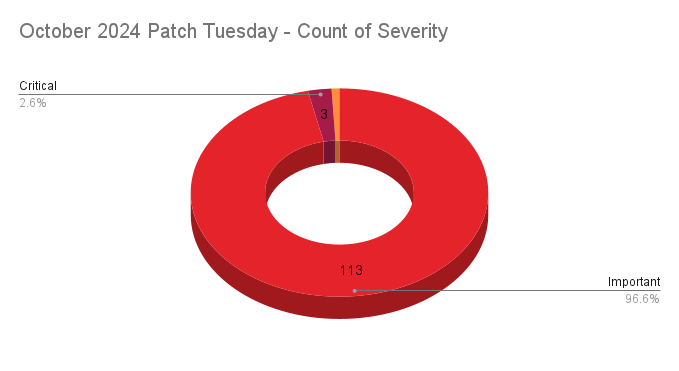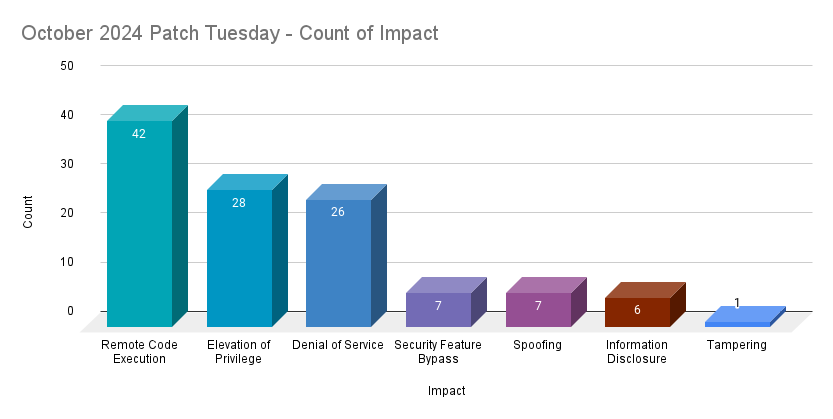Microsoft’s October 2024 Patch Tuesday Addresses 117 CVEs (CVE-2024-43572, CVE-2024-43573)

- 3Critical
- 113Important
- 1Moderate
- 0Low
Microsoft addresses 117 CVEs with three rated as critical and four zero-day vulnerabilities, two of which were exploited in the wild.
Microsoft patched 117 CVEs in October 2024 Patch Tuesday release, with three rated critical, 113 rated important and one rated moderate. Our counts omitted one vulnerability reported by Hackerone.

This month’s update includes patches for:
- .NET and Visual Studio
- .NET,.NET Framework, Visual Studio
- Azure CLI
- Azure Monitor
- Azure Stack
- BranchCache
- Code Integrity Guard
- DeepSpeed
- Internet Small Computer Systems Interface (iSCSI)
- Microsoft ActiveX
- Microsoft Configuration Manager
- Microsoft Defender for Endpoint
- Microsoft Graphics Component
- Microsoft Management Console
- Microsoft Office
- Microsoft Office Excel
- Microsoft Office SharePoint
- Microsoft Office Visio
- Microsoft Simple Certificate Enrollment Protocol
- Microsoft WDAC OLE DB provider for SQL
- Microsoft Windows Speech
- OpenSSH for Windows
- Outlook for Android
- Power BI
- RPC Endpoint Mapper Service
- Remote Desktop Client
- Role: Windows Hyper-V
- Service Fabric
- Sudo for Windows
- Visual C++ Redistributable Installer
- Visual Studio
- Visual Studio Code
- Windows Ancillary Function Driver for WinSock
- Windows BitLocker
- Windows Common Log File System Driver
- Windows Cryptographic Services
- Windows EFI Partition
- Windows Hyper-V
- Windows Kerberos
- Windows Kernel
- Windows Kernel-Mode Drivers
- Windows Local Security Authority (LSA)
- Windows MSHTML Platform
- Windows Mobile Broadband
- Windows NT OS Kernel
- Windows NTFS
- Windows Netlogon
- Windows Network Address Translation (NAT)
- Windows Online Certificate Status Protocol (OCSP)
- Windows Print Spooler Components
- Windows Remote Desktop
- Windows Remote Desktop Licensing Service
- Windows Remote Desktop Services
- Windows Resilient File System (ReFS)
- Windows Routing and Remote Access Service (RRAS)
- Windows Scripting
- Windows Secure Channel
- Windows Secure Kernel Mode
- Windows Shell
- Windows Standards-Based Storage Management Service
- Windows Storage
- Windows Storage Port Driver
- Windows Telephony Server
- Winlogon

Remote code execution (RCE) vulnerabilities accounted for 35.9% of the vulnerabilities patched this month, followed by elevation of privilege (EOP) vulnerabilities at 23.9%.
CVE-2024-43572 | Microsoft Management Console Remote Code Execution Vulnerability
CVE-2024-43572 is a RCE vulnerability in Microsoft Management Console (MMC). It was assigned a CVSSv3 score of 7.8 and is rated as important. An attacker could exploit this vulnerability by convincing a vulnerable target through the use of social engineering tactics to open a specially crafted file. Successful exploitation would allow the attacker to execute arbitrary code. According to Microsoft, CVE-2024-43572 was exploited in the wild as a zero-day. This is the second month in a row that Microsoft patched a RCE vulnerability in the MMC, as Microsoft addressed CVE-2024-38259 in its September 2024 Patch Tuesday release.
As part of its patch for CVE-2024-43572, Microsoft has altered the behavior for Microsoft Saved Console (MSC) files, preventing untrusted MSC files from being opened on a system.
CVE-2024-43573 | Windows MSHTML Platform Spoofing Vulnerability
CVE-2024-43573 is a spoofing vulnerability in the Windows MSHTML Platform. It was assigned a CVSSv3 score of 6.5 and is rated as moderate. An unauthenticated, remote attacker could exploit this vulnerability by convincing a potential target to open a malicious file. According to Microsoft, CVE-2024-43573 was exploited in the wild as a zero-day.
This is the fourth zero-day vulnerability in the Windows MSHTML Platform that was exploited in the wild in 2024, which include CVE-2024-30040, a security feature bypass flaw that was patched in May 2024, CVE-2024-38112, a spoofing vulnerability that was patched in July 2024 and CVE-2024-43461, a spoofing vulnerability that was patched on September 10, 2024, though details about in-the-wild exploitation was not known until September 13, 2024. Both CVE-2024-38112 and CVE-2024-43461 were used as part of an exploit chain by an advanced persistent threat (APT) actor known as Void Banshee.
CVE-2024-20659 | Windows Hyper-V Security Feature Bypass Vulnerability
CVE-2024-20659 is a security feature bypass vulnerability in Windows Hyper-V. It was assigned a CVSSv3 score of 7.1, is rated as important and assessed as “Exploitation Less Likely” according to Microsoft’s Exploitability Index. This is likely due to the fact that there are multiple conditions that need to be met in order for exploitation to be feasible, such as a user rebooting their machine and application specific behavior among other user-required actions. Successful exploitation would allow an attacker to bypass a Virtual Machine’s Unified Extensible Firmware Interface (UEFI) on the host machine, resulting in both the hypervisor and secure kernel being compromised. According to Microsoft, CVE-2024-20659 was publicly disclosed prior to a patch being made available.
In addition to CVE-2024-20659, Microsoft also addressed three denial of service (DoS) vulnerabilities and one RCE in Windows Hyper-V:
| CVE | Vulnerability Type | Severity | CVSSv3 |
|---|---|---|---|
| CVE-2024-30092 | RCE | Important | 8 |
| CVE-2024-43521 | DoS | Important | 7.5 |
| CVE-2024-43567 | DoS | Important | 7.5 |
| CVE-2024-43575 | DoS | Important | 7.5 |
CVE-2024-43583 | Winlogon Elevation of Privilege Vulnerability
CVE-2024-43583 is an EoP vulnerability in Winlogon. It was assigned a CVSSv3 score of 7.8 and is rated as important. A local, authenticated attacker could exploit this vulnerability to gain SYSTEM privileges. According to Microsoft, CVE-2024-43583 was publicly disclosed prior to a patch being made available.
In addition to applying the available patch for CVE-2024-43583, Microsoft recommends enabling Microsoft first-party Input Method Editor (IME) in order to thwart vulnerabilities within third-party IMEs. For more information on enabling first-party IME, please refer to the knowledge base article KB5046254.
CVE-2024-38212, CVE-2024-38261, CVE-2024-38265, CVE-2024-43453, CVE-2024-43549, CVE-2024-43564, CVE-2024-43589, CVE-2024-43592, CVE-2024-43593, CVE-2024-43607, CVE-2024-43608, CVE-2024-43611 | Windows Routing and Remote Access Service (RRAS) Remote Code Execution Vulnerability
CVE-2024-38212, CVE-2024-38261, CVE-2024-38265, CVE-2024-43453, CVE-2024-43549, CVE-2024-43564, CVE-2024-43589, CVE-2024-43592, CVE-2024-43593, CVE-2024-43607, CVE-2024-43608 and CVE-2024-43611 are a series of RCE vulnerabilities in Windows Routing and Remote Access Service (RRAS) accounting for 10% of the vulnerabilities in the October Microsoft Patch Tuesday update. All 12 of these vulnerabilities share a common CVSSv3 score of 8.8 with the exception of CVE-2024-38261 which was assigned a score of 7.8. Each of these vulnerabilities are rated by Microsoft as “Exploitation Less Likely” and share similar attack paths based on Microsoft's descriptions of the vulnerabilities. An attacker with no authentication could leverage this vulnerability by targeting a vulnerable server with a specially crafted protocol message or tricking a user to submit a request to a malicious server resulting in a malicious message being returned, which could lead to RCE on the vulnerable machine.
CVE-2024-43533 and CVE-2024-43599 | Remote Desktop Client Remote Code Execution Vulnerability
CVE-2024-43533 and CVE-2024-43599 are a pair of RCE vulnerabilities in Microsoft Remote Desktop Client, both with a CVSSv3 score of 8.8 and flagged by Microsoft as “Exploitation Less Likely.” The attack vector noted by Microsoft lists a prerequisite of an attacker first compromising a Remote Desktop Server. Once compromised, the attacker can leverage RCE against vulnerable connecting devices. As a mitigating factor and part of security best practices, it is suggested that the Remote Desktop service should be disabled if not needed. Microsoft’s advisory further explains that disabling unused services can help reduce exposure.
CVE-2024-43468 | Microsoft Configuration Manager Remote Code Execution Vulnerability
CVE-2024-43468 is a RCE in Microsoft Configuration Manager listed as “Exploitation Less Likely” by Micorosft despite having a critical CVSSv3 score of 9.8, the highest in October's Patch Tuesday update. An attacker can leverage this vulnerability without prior authentication by sending a specially crafted request to a vulnerable machine resulting in RCE on the machine or its underlying database.
Microsoft has advised impacted users to install an in-console update as the only mitigation path, but has listed a workaround for users who cannot immediately implement the updates. The workaround suggested by Microsoft is to use an alternate service account for the Management point connection account in place of the default “Computer” account.
CVE-2024-38124 | Windows Netlogon Elevation of Privilege Vulnerability
CVE-2024-38124 is a EoP vulnerability in Windows Netlogon assessed as “Exploitation Less Likely” with a CVSSv3 score of 9, the second highest in the October Patch Tuesday update. An attacker would need authenticated access to the same network as a vulnerable device and rename their machine to match the domain controller in order to establish a secure channel. If these prerequisites are met, the attacker would then need to rename their machine back to its original name and “once the new domain controller is promoted, the attacker could use the secure channel to impersonate the domain controller and potentially compromise the entire domain.”
There are no workarounds listed for this vulnerability, but if immediate patching is not an option, Microsoft has listed a handful of mitigating factors to consider:
- Avoid using predictable naming conventions on Domain Controllers
- Ensure Secure Channel validation requires more than just a matching computer name.
- Monitoring for the renaming of computers within the network.
- Consider enhanced authentication mechanisms.
Tenable Solutions
A list of all the plugins released for Microsoft’s October 2024 Patch Tuesday update can be found here. As always, we recommend patching systems as soon as possible and regularly scanning your environment to identify those systems yet to be patched.
For more specific guidance on best practices for vulnerability assessments, please refer to our blog post on How to Perform Efficient Vulnerability Assessments with Tenable.
Get more information
- Microsoft's October 2024 Security Updates
- Tenable plugins for Microsoft October 2024 Patch Tuesday Security Updates
Join Tenable's Security Response Team on the Tenable Community.
Learn more about Tenable One, the Exposure Management Platform for the modern attack surface.
- Exposure Management
- Vulnerability Management


